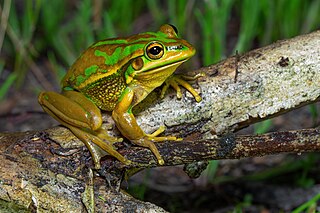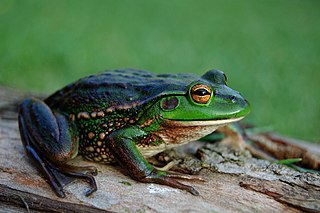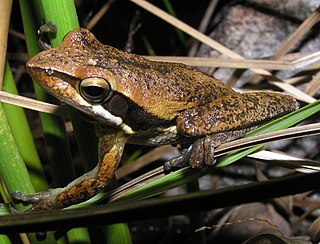
Litoria is a genus of hylid tree frogs, sometimes collectively referred to as Australasian treefrogs.

The green and golden bell frog, also named the green bell frog, green and golden swamp frog and green frog, is a species of ground-dwelling tree frog native to eastern Australia. Despite its classification and climbing abilities, it does not live in trees and spends almost all of its time close to ground level. It can reach up to 11 cm (4.5 in) in length, making it one of Australia's largest frogs.

The Australian green tree frog, also known as simply green tree frog in Australia, White's tree frog, or dumpy tree frog, is a species of tree frog native to Australia and New Guinea, with introduced populations in the United States and New Zealand, though the latter is believed to have died out. It is morphologically similar to some other members of its genus, particularly the magnificent tree frog (R. splendida) and the white-lipped tree frog (R. infrafrenata).

The magnificent tree frog, also known as the splendid tree frog, is a species of tree frog first described in 1977. It has a limited range, only occurring on the north-western coast of Australia in the Northern Territory and Western Australia. It has a similar appearance to, and can be confused with, the closely related White's tree frog.

The bleating tree frog, also known as Keferstein's tree frog, is a species of tree frog in the subfamily Pelodryadinae. This frog is native to coastal eastern Australia, from south-eastern Queensland, to around Eden, New South Wales.

The growling grass frog, also commonly known as the southern bell frog, warty swamp frog and erroneously as the green frog, is a species of ground-dwelling tree frog native to southeastern Australia, ranging from southern South Australia along the Murray River though Victoria to New South Wales, with populations through Tasmania. This species' common names vary between states; the name southern bell frog applies in New South Wales and South Australia, growling grass frog in Victoria, and green and gold frog in Tasmania. This species has been introduced to New Zealand.

Freycinet's frog, also known as the wallum rocket frog, is a species of frog. It inhabits coastal areas from Fraser Island, Queensland, south to the Jervis Bay Territory of New South Wales.

The Blue Mountains tree frog also called the variegated river tree frog is a species of tree frog in the subfamily Pelodryadinae. It is endemic to southeastern Australia and is found in eastern Victoria and in southeastern New South Wales. The Jenolan Caves tree frog, a population formerly separated as Litoria jenolanensis, is nowadays included in this species.

The southern brown tree frog, also known as the brown tree frog, whistling tree frog, or Ewing's tree frog, is a species of tree frog native to Australia: most of southern Victoria, eastern South Australia, southern New South Wales from about Ulladulla—although this species is reported to occur further north—and throughout Tasmania including the Bass Strait Islands, in which state it is the most frequently encountered frog. It has been introduced to New Zealand, where it can be locally abundant.

The striped rocket frog, or in its native range known as the rocket frog, is a species of frog that occurs mostly in coastal areas from northern Western Australia to around Gosford in New South Wales at its southernmost point, with a disjunct population occurring further south at the Sydney suburb of Avalon. It also inhabits the southern lowlands and south east peninsula of Papua New Guinea.

The slender tree frog is a tree frog native to south-western Australia.
Ranoidea vagitus, the wailing frog, is a species of tree frog occupying the arid and monsoonal Kimberley region. It is a ground dweller, which evades dry periods by burrowing and hibernating - emerging to breed during floods.

The knife-footed frog is a species of burrowing frog in the family Hylidae. It is endemic to Australia, where it is found over a wide area in the north of the continent.

Copland's rock frog or the saxicoline tree frog is a species of frog in the subfamily Pelodryadinae. It is endemic to Australia, in a range extending from the Kimberley region of Western Australia to Arnhem Land and a record in the north of Queensland. Its natural habitats are subtropical or tropical dry shrubland, subtropical or tropical dry lowland grassland, intermittent rivers, and rocky areas.
The long-snouted frog is a species of frog in the subfamily Pelodryadinae. It is endemic to Australia. The frog is also known as the long-nosed tree frog, scrub rocket frog, and sharp-snouted frog.

The Wotjulum frog is a species of frog in the subfamily Pelodryadinae. Its habitats are subtropical or tropical dry forests, subtropical or tropical moist lowland forests, subtropical or tropical swamps, rivers, intermittent rivers, swamps, freshwater lakes, freshwater marshes, intermittent freshwater marshes, and rocky areas.

Ranoidea wilcoxii, also known as the stony-creek frog, eastern stony creek frog, and Wilcox's frog, is a species of frog in the subfamily Pelodryadinae. It is endemic to Australia, being found solely on the eastern coast between Ingham, QLD, and Sydney, NSW, and as far west as Atherton, QLD. Its natural habitats are subtropical or tropical dry forests, subtropical or tropical moist lowland forests, rivers, intermittent rivers, and pastureland.
Watson's tree frog, also known as the large brown tree frog or southern heath frog, is a species of tree frog endemic to south-eastern Australia.
The Kimberley rockhole frog is a species of small treefrog that is endemic to Western Australia. The species epithet aurifera (‘gold-bearing’) refers to the colouring of the tadpoles.
The chattering rock frog is a species of frog that is endemic to Western Australia. The species epithet staccato and the common name refer to the sound of its call.













